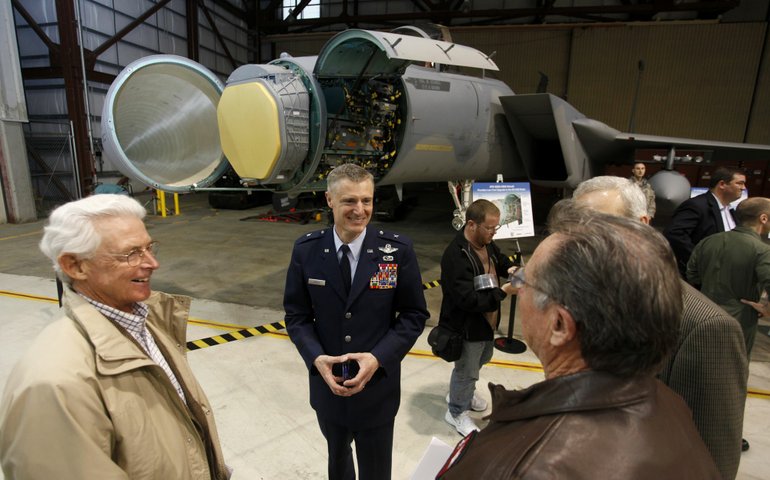o When the Oregon Air National Guard’s 321st Squadron was called to active duty in 1941, Pearson Field in Vancouver ceased to be an active Army Air Corps base.
PORTLAND — A military aviator based in Vancouver in 1941 had an idea that’s now known as “Oregon’s hometown air force.”
On Friday, seven World War II veterans of the 123rd Observation Squadron were in the front row for a celebration of the Oregon Air National Guard’s 70th anniversary.
“We’d like to think that we single-handedly won the war,” said Fred Parish, one of the first volunteers for the Portland-based aviation outfit. After a short pause, Parish added, “Well, maybe …”
The event inside a hangar at Portland Air National Guard Base looked back at an idea proposed by an Army officer in 1941. Oregon resident Maj. G. Robert Dodson was serving with the 321st Observation Squadron Reserve at Pearson Field in Vancouver. He asked National Guard officials to form an Oregon flying unit. On April 18, 1941, the 123rd Observation Squadron was launched with a contingent of 117 volunteers at Portland’s Swan Island airfield.
It would become the first unit to conduct wartime surveillance off the Northwest’s Pacific Coast.
“After Pearl Harbor, it flew sub(marine) watch missions over the Oregon and Washington coast,” said Col. Mike Bieniewicz, a Vancouver resident who is vice commander of the 142nd Fighter Wing.
The 142nd now carries the flag for the Air National Guard in the Portland-Vancouver area. From a third to half of the fighter wing’s 1,200 members live in Clark County. The entire Oregon Air National Guard consists of about 2,200 members, including the 173rd Fighter Wing in Klamath Falls and a headquarters unit in Salem.
Not everybody could attend Friday’s celebration, Bieniewicz added, because some are deployed overseas. They’re continuing a tradition of wartime service that goes back to Vietnam, Korea and WWII.
Those original members of the 123rd Observation Squadron recalled their wartime duty seven decades or so ago.
“The powers that be scattered us all over dickens,” Parish said. He was a medical specialist and flight surgeon’s assistant who spent most of his time overseas in Calcutta, India.
Ben Olbrich wound up in The Philippines.
“A friend of mine joined (the 123rd); I was going to get drafted, and I wanted to go with my buddy,” said Olbrich, whose son lives in Vancouver. (His granddaughter, Skyview grad Abby Olbrich, is a two-sport athlete at Linfield College who was featured in a Columbian sports story recently.)
It wasn’t flying that drew him to the aviation squadron.
“Not really. I was interested in mechanics,” Olbrich said. “I was a crew chief for P-38 fighters.”
Fred Hill was a photographer with a B-25 photo reconnaissance unit in the South Pacific. He shared one of his memorable moments, which had nothing to do with military aviation. It was more like a totally new take on trench warfare.
His unit was being transferred between Pacific islands, and several landing craft had pulled up to the beach to unload equipment. The same beach was the site of a slit trench that served as a latrine, complete with toilet seats crafted from 55-gallon steel drums.
One of the landing craft couldn’t get close enough to the beach to lower its ramp and unload, so the skipper backed off a mile or so to get a running start, Hill said.
“Can you visualize a tsunami?” Hill asked. The resulting wave when the landing craft hit the beach “washed away all those pants-down sailors.”
The event also marked the rollout of six upgraded F-15C fighters with advanced radar. The Boeing-made systems will increase pilots’ capabilities in air combat as well as homeland security missions.
An F-15 with the older radar system has to point its nose-mounted antenna at a target, said Brig. Gen. Steven D. Gregg, commander of the Oregon Air National Guard. If a second target appears, the pilot has to swing the F-15 around and point at it, too.
“This radar has the ability to track more than one target,” Gregg said as he pointed out the radar system in a F-15 on display.
It can also handle much smaller threats. They include unmanned miniature aircraft that might be turned into terrorist weapons against cities.
Or, as Gregg called them: “Radio-controlled airplanes on steroids.”




